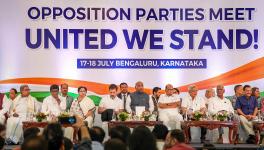A Tale of Failures and their Persistence
An article on the state of the Indian Maoists and the State's actions to address the"Maoist challenge"
The Indian Maoists have been described as the greatest security threat to the nation by the Indian government and although there is a great degree of exaggeration involved in the statement, it is also a fact that the Indian Maoists have reached a position of significance that they did not enjoy just a few years ago.Consequent to these descriptions, the Indian government has suggested through feelers that it contemplates a military solution to the "Maoist problem", one that involves special task paramilitary forces that would take on the Maoist Peoples' Liberation Army to frontal combat.
This has also been flanked by statements on addressing the socio-economic situation that has given rise to the "Maoist problem" in the first place. The trouble with the government's view is that its emphasis on a military solution would entail a long drawn out "civil war" against a primarily guerilla outfit which has thus far managed hits and runs and and not graduated into a more stronger "liberation army" howmuchsoever the government wants to "escalate" its threat value. Having said that, there has been a definite spurt in Maoist violence across the country in the past few years, notwithstanding setbacks to the Maoist forces.
The strength of the Indian Maoists has increased especially since the merger of the two large insurrectionist Naxalite organisations, the Peoples' War Group and the Maoist Communist Centre in 2004. Since then, the Maoists first tried out a political compromise when they emerged for talks with the Andhra Pradesh government, which eventually fizzled out as the AP government used the interregnum for talks to consolidate their position and weaken the Maoists. They were then militarily defeated in Andhra Pradesh by the concerted actions of the police force- particularly the "elite" Greyhound commando forces[i], which was far better a security tool that approximated the guerilla strategies of the Maoists' People's Liberation Army than just the police and was eventually able to overcome the Maoists in the state, so much so, that the Maoists' leadership had to take refuge in the "Dandakaranya region" adjoining Chhattisgarh, Orissa and Andhra Pradesh. As recently deceased human rights activist, K. Balagopal pointed out in a telling essay some years ago, the Maoists were defeated not just by the brute force of the state's machinery, but also by their own praxis. By shifting their praxis from grievance and alternative politics driven to military based mobilisation, the Maoists eventually lost much support - a must in a guerilla struggle and were forced to retreat from Andhra Pradesh.Lately, even the mass organisations of the Maoists have been marginalised; some Maoist sympathisers have tried to bandwagon with the new political outfit launched by actor Chiranjeevi, which had promised a pro-poor agenda. But those ambitions have been frustrated with the Praja Rajyam Party's defeat as well as by the entry of opportunist "money bag elements" into the party.
The MCC component, which has been commented to be more anarchic in its activities\ than the more "organised" PWG component, meanwhile continued its unabated activities in the Jharkhand state, where they have also indulged in extortion activities used to fund their "war chest". The Maoists meanwhile have targetted newer areas where there is severe discontent to work out their political and military praxis. The Bastar region of Chhattisgarh was one such, where the mining contractor - bureaucrat – politician- industrial nexus was intact and which gave reasons for the Maoists to mobilise tribals against this nexus. In retaliation, the state polity brought about the dangerous Salwa Judum programme, which pits tribal against tribal and created a vigilante force against the Maoists and the tribals who support them. The result was severe displacement of tribals from their villages into relief camps and widespread anarchy with tribals caught in the crossfire between the Salwa Judum and the Maoists. The Bastar region remains volatile, as even social service organisations such as the Vanvasi Chetna Ashram have been caught in this crossfire. The state has targetted any social/ civil society outfit as being Maoist sympathisers using draconian laws such as the Public Security Act, while the Maoist actions such as abductions of local level state government officials or wanton disruption of elections has given fillips to a vengeful state to retaliate. The Maoists on the other hand, have also indulged in wanton murder of village headmen, sarpanches; have bent on militarising the tribals and thrown them in the deep well of the violence among themselves
For years, the Maoists have been steadily building a political movement in other tribal dominated areas severely hampered by under-development and social backwardness, such as in Gadchiroli in south eastern Maharashtra. The recent spurt in violence in the district is a direct consequence of the state trying to get back its "influence" in the area after systematic neglect for years. The Maoists have also been active for a few years in the Kalahandi region of Orissa, which is another zone of poverty, and commercial exploitation of natural resources. Over the past year or so, the Maoists have been trying to expand their influence into the communally sensitive areas of Orissa, such as in the Kandhamal district. By definite accounts, the Maoists were responsible in the Vishwa Hindu Parishad leader Laxmananda Saraswati murder, which triggered a murderous reaction by the Hindu communalists of the Sangh Parivar against Christian tribals and institutions. Kandhamal is still not off the boil, as the Sangh Parivar has simply used the Maoist actions as a ruse to target Christian tribals.
The Maoists have been unsuccessful in trying to work out their praxis in other regions; Karnataka for example. Here, the entire state unit of Karnataka split from the Maoists detailing their dissidence on the basis of their opposition to the anarchic violence and the "incorrect" understanding of the Indian society and polity by the part The Karnataka wing has now become a "non-violent" political and left organisation.
The pattern of Maoist involvement in many areas in the country is revealing. The Maoists have tactically descended upon the idea of working their praxis not immediately on an all-India level, but in assorted areas where it is difficult for the organs of the state to defeat them militarily and to build their base areas in these locationsThere is a great degree of social discontent and there is very little development in these areas or what transpires for "development" activity is merely a front for commercial exploitation of tribal/rural habitats. The Maoists then enmesh themselves in these areas through opposition and mobilisation against the state and try to work out their political praxis of working out a base area, consolidating their hold by targetting institutions of the state by violent means. These means include disruption of the formal activity of elections, damaging developmental work such as roads, schools and others set up by the state, killing people identified with political outfits that are seen to be antithetical to the Maoists. Invariably the state retaliates and the very people whom the Maoists show their concern for, are caught in the crossfire. The Maoists then explain these actions to reveal the "naked face of the state"; while the state invariably takes recourse to draconian laws and actions to justify their security based response against the Maoists.
Maoist actions in West Bengal
That now takes us to West Bengal. Contradictory to many an assertion by the political opposition in the state, the movement against land acquisition in Nandigram was triggered with more than substantive work by the Maoists. The Maoists have themselves acknowledged this in a number of interviews. One such interesting interview of Koteshwar Rao suggests that the Maoists were also involved in the Keshpur incidents in the early part of this decade, then pitting themselves against the Trinamul led elements. The Maoists have indulged in "hit and run" work from Jharkhand in west Midnapore for sometime now. Yet, importantly, the Maoist (Naxalite to be precise) presence and influence in West Bengal was significantly reduced - primarily because of the Left government's earlier successes in land reforms and focussed rural development and strengthening of local democracy.
Having said that, studies (EPW Special Issue, February 2009, “Local Government in Rural West Bengal”), have identified trends that explain the fraying away of the rural "gains" made by the left. While panchayati raj has instituted local democracy and shifted the loci of government to the local village panchayat making it the most powerful institution in the rural areas;long and entrenched rule of the left has developed tendencies of corruption or more protractedly clientalism at the local grassroots levels in parts of the state. Systems of patronage based on political allegiances have been effected in many rural areas that has fed in discontent at some levels. The objective conditions in Lalgarh for example, mirror this story as some reports point out. Malini Bhattacharya's article on Lalgarh points out to an objective assessment that tries to understand the reasons for the discontent while putting into perspective, the Maoists' turf war against the CPI(M) in the area.
A key question remains- what is the end that the Maoists are trying to achieve in West Midnapore or even in West Bengal? Are they thinking that they would keep building a liberated base area in the region, knowing fully well that they would invite sovereign action by the state in the form of security measures to protect state institutions - here, Panchayat samitis, zilla parishads, gram sabhas in the area? Why would any state government remain a mute spectator to a virtual take over of its sovereign actions by extra-legal elements? The Maoists think they are justified in doing so, because it flows from their praxis of creating alternate power structures, but given their failure elsewhere to prevent the hold of electoral democracy or democratic instruments on the electorate and the poor, what makes them think that they would be successful in doing so in a state, where the formal instruments of democracy are even more vibrant and entrenched? That annihilation of anyone having different political allegiances is a way out of winning a so called "class war" is inherently a diabolic, anarchic, authoritarian and in every sense a Pol-Potist discourse. And the Maoists in this case are adopting the methods of annihilation and rampant killing to defeat the Left, tacitly supported by the opportunist right wing forces such as the Trinamul and the Congress, who are looking for a ruse to dismiss the Left Front government in the state.
Surely the Maoists are leading the tribals to a violent abyss by these anarchic actions and they do it realising this very well. The Maoists are trying to foment a revolution - there is no doubt about that. They consider that the bourgeois democracy in India is a facade that hides entrenched class interests and class control over levers of power. They consider that it is not just enough to force the state to bring in welfare measures as they are crumbs to the needy which doesn't hide the structural orientation of the comprador-bureaucratic-bourgeoisie ruled state. But in this endeavour, they consider that it is the "parliamentary Left" that is their primary enemy now as is evidenced by their strategy in West Bengal, which has prefaced their tacit understanding with political parties such as the Trinamul Congress.
Setback to the left movement in the entire country
Any simple reading of the electoral system and polity in India would reveal that there is a derived bipolarity between the Congress and the BJP in the electoral system and large consensus on economic policy among the ruling classes. This consensus is evaded only by the left parties at the national level, which has articulated a break from both neoliberalism and greater integration with “imperialism” at the world level, may it be in the form that the left opposed the implementation of neoliberal policy formulations or in the way the entire nuclear deal issue was played out. Even radical parties such as the CPI(ML)-Liberation acknowledge the loss of the left voice in Parliament as a setback despite their reservations about the praxis of the larger left parties. And even those who believe in social democracy and in upholding Constitutional values have lamented the loss of the left, may it be in articulating a social agenda for the nation as a whole or in articulating an independent voice in foreign policy. But the Maoists, here have considered the left front as their primary enemy and embark upon a similar praxis as is evident in their work in other states (incidentally none of them is Congress ruled).
The Lalgarh incidents and the rampant killings of CPI(M) party workers might put the CPI(M) led Left Front on the back foot in the state of West Bengal. The Left is now in a state of introspection over the defeat in the recent parliamentary elections. The deliberate mobilisations against the left from a varied coalition of forces from the ultra-right (the Sangh parivar's intrusion in Darjeeling) to the right (the Trinamul and Congress Alliance, which is now using violence to quell the left's hold after elections) to the ultra-left (the Maoists) has only pushed the left movement in the country as a whole further into the backfoot. That is because the actions by the Maoists seem to want to push the balance of support toward rightist forces in the state of West Bengal - in other words, the opportunist Trinamul Congress and the distinctly neoliberal Congress. Any leftist would bristle at this culmination despite reservations with the governance and policies of the long running left front government in the state of late.
Lessons to be drawn
The central government repeated harping on the "greatest internal security threat" that the Maoists provide, is certainly hyperbolic. But the insistence on such a rhetoric is primarily driven by the fact that the Maoists have increasingly concentrated in areas, which are rich in natural resources and are coveted by big companies for commercial purposes. Of late, however, the central government has started to make statements about socio-economic development of the regions currently under some influence of the Maoists. Consequently, the Maoists have responded in attacking the developmental agencies and structures of the state in a manner that has brought in greater repression. In many ways, even if the Maoist actions and the state counter-actions (or vice versa) are not the "greatest internal security" problem, the situation is indeed a great tragic livelihood problem in the tribal dominated areas where the Maoists have a significant presence.
The existing crossfire, be it in the form of battles between vigilante tribal forces and the Maoists in Chhattisgarh or the violent turf war launched by the Maoists against ruling party supporters in West Bengal or the tactic of individual "annihilation" of perceived enemies by the Maoists in Orissa has created a great cesspool of violence and counter-violence. The immanent "massive" paramilitary response, without a concomitant administrative impetus on livelihood issues would only widen this cesspool. The Indian state by embarking upon a wholly militant offensive, would further alienate an already traumatised population if it resorts to a full scale offensive against the guerilla army of the Maoists on the lines of what transpired in Sri Lanka against the Liberation Tigers of Tamil Eelam. Having said that, the anarchic use of violence, and the terroristic acts of "annihilation" have drawn such as response, for which the Maoists are completely to blame. In this respect they have much to learn from their Nepali counterparts who have successfully established great bases of support among the Nepali populace through varied tactics of democratic engagement going beyond mere military consolidation. And indeed from the failures of similar anarchic and military oriented Maoist organisations such as the Sendero Luminoso in Peru.
The inability of the Maoists to transform their spark in 1967 into a prairie fire as late as 2009 is indicative of the stupendous failure of the Maoist praxis. And the continuing presence of under-development, poor human development indicators, exploitation and oppression in areas where the Maoists are strong; point toward the failure of formal Indian democracy. There has to be a great substantive basis for Indian democratic institutions objectively and a more wholesome democratic agency that is people-centric to achieve the same. That is the challenge to be addressed by progressive and democratic sections of Indian polity today.
References
Bannerjee, Sumanta (2006), “Beyond Naxalbari”, Economic and Political Weekly, July 22-28
Bhattacharya, Dwaipayan (2009), “Of Control and Factions: The Changing “Party-society” in West Bengal, Economic and Political Weekly, Febraury 22
Kumar, Arun (2003), Violence and Political Culture - Politics of the Ultra Left in Bihar, Economic and Political Weekly, November 22
Sundar, Nandini (2006), Bastar, Maoism and Salwa Judum, Economic and Political Weekly, July 22-28
[i] This is explained in this article, “Government hits back” by N.Rahul in the Frontline magazine, dated October 8,2005
[ii] A news report that details the entry of ex-Naxalites and also the popular support to the PRP from Naxal ideologues during the course of the formation of the party is available at http://timesofindia.indiatimes.com/3000-ex-Maoists-line-up-to-join-Chiranjeevis-party/articleshow/4168356.cms ;.
[iii] See Kumar (2003). Although this article generically focuses on “ultra left” violence, it specifically mentions the MCC component's tryst with criminalism.
[iv] A very telling study of the Maoists and the situation in Bastar, Chhattisgarh is presented in Sundar (2006).
[v] http://rcpkarnataka.blogspot.com/2008/02/study-document-1-25-years-expe… explains the reasons for the breakaway of the Karnataka unit from the Maoists in great detail
[vi] See Bannerjee (2006). Bannerjee suggests that the Indian Maoists have adopted this from the understanding of the MCC component.
[vii] In this the Indian Maoists are very different from their Nepali counterparts (who have entered the democratic mainstream now), who even during the days of their “Peoples' War”, were insistent on ensuring that their praxis did not become “red terror”. This is evident in the call given by the Nepali Maoists' chairman, Prachanda to his comrades, that “a certain mininum legal method is adhered to” and that, “it should be strictly expressed in both our policy and practice that red terror does not mean anarchy” (Bannerjee 2006)
[viii] Check interview of Maoist leader Koteswar Rao here : http://www.livemint.com/2009/05/29001232/Mainstream-politics-not-for-us.html
[ix] This is acknowledged even by sympathetic commentators of the Naxalbari movement such as Sumanta Bannerjee (2006)
[x] Bhattacharya (2009) illustrates this with a study of two villages in West Bengal.
[xi] ML Update editorial titled, “Verdict 2009” – Lessons for the Left available at http://www.cpiml.org/pgs/ml_upd/VOL12/12_21.html#1
Get the latest reports & analysis with people's perspective on Protests, movements & deep analytical videos, discussions of the current affairs in your Telegram app. Subscribe to NewsClick's Telegram channel & get Real-Time updates on stories, as they get published on our website.
























